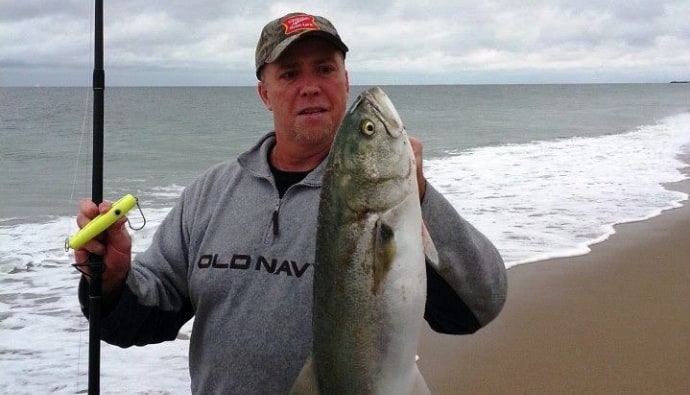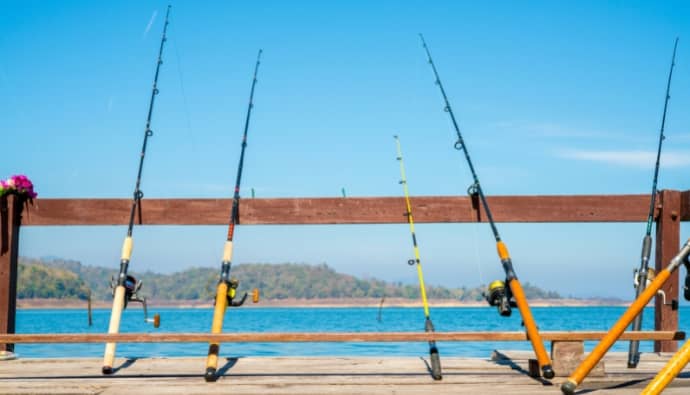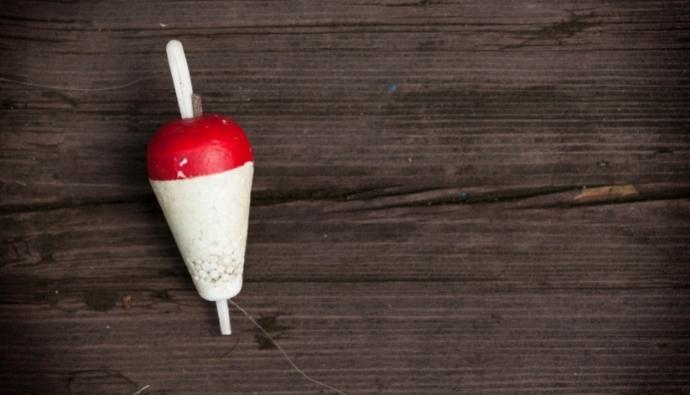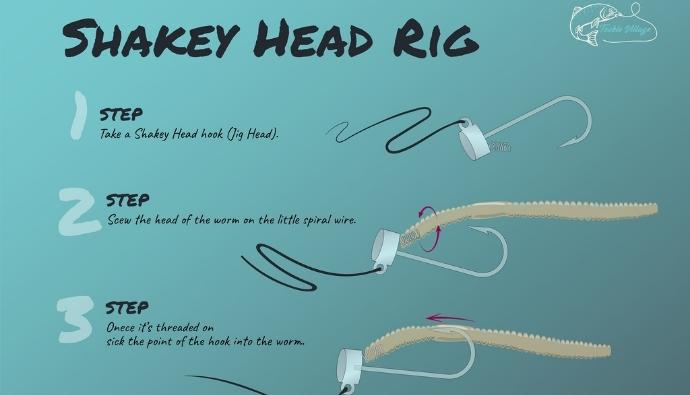You’d be surprised how many fish swim a few feet from shore. Depending on the structure of your favorite beach, they can be found in troughs in the sand, holes, near submerged rocks, and other structures while they search for food.
The best surf fishing rig depends on the fish species you’re targeting and the structure you’re fishing. For light-line surf fishing near sandy bottoms, try the Carolina Rig or the Fish Finder Rig. If your target zone is further out, try a Clip Down Pulley Rig to keep your weight and bait streamlined during the cast.
5 Best Surf Fishing Rigs

Fish Finder Rig
The fish finder rig is excellent for naturally presenting a piece of bait across sandy bottoms. If you look closely, the fish finder rig is similar to a Carolina Rig but uses a pyramid sinker instead of an egg sinker. Instead of a pyramid sinker, you can use a special clip and fasten a steel weight such as a bolt or spark plug.
The fish finder rig does have some drawbacks since you have three knots between you and the fish and a sliding sinker that can damage your line if you’re not careful.
Check out our How to Tie a Fish Finder Rig Guide for a step-by-step build.
Carolina Rig
The Carolina Rig is popular in Southern California along beaches with little hard structure or kelp. Many fishermen use it for surf fishing using the light lines for corbina, surfperch, and halibut.
This rig is easy to tie, but it does help to have a few pre-made Carolina rigs in your saltwater tackle bag.
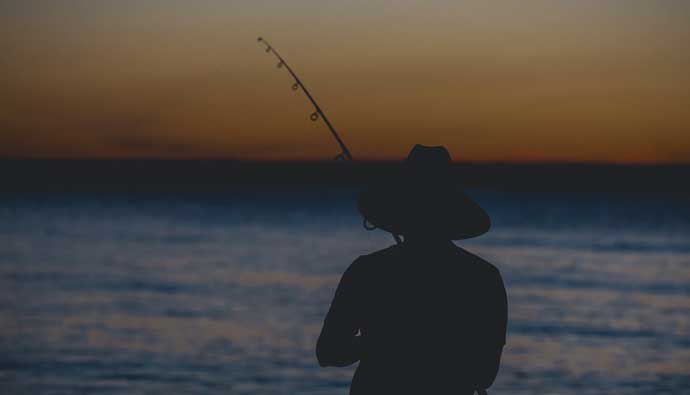
Flapper Rig
For most surf fishing, you will find that a simple flapper rig, either a one, two, or three-hook version, can best fit your needs.
These are the simplest and often most influential of all surf fishing rigs. They produce excellent results.
The best approach is to tie the hook trace, also called a snood, onto a swivel and locate the swivel on the body line between a couple of beads and locking crimps.
This gives the snoods a better chance of dealing with any line twists caused by the bait flapping around as it flies through the air on the cast. Or while sinking to the seabed.
On a two or three-hook flapper rig, the lower snood can be longer to give better bait separation on the seabed.
Tied in this way, they are known as ‘1up-1down’ or ‘2up-1down’ flapper rigs.
Clipped Rigs for Longer Range Surf Casting
Clip down surf fishing rigs is more complex than flapper rigs, involving two more components, a bait clip for each snood and a bait stop for each snood.
These 1, 2, and 3-hook clipped rigs end in a link clip rather than a bait clip. This means that an impact lead must be used to provide a clip for the lower hook to be clipped to.
In the 2 and 3-hooked rigs, the rolling swivel at the inner end of the dropper has been replaced by a cascade swivel. This incorporates a clip for the hook above it.
Impact Leads
Pulley rigs use the swivel to act as a pulley between the weight and the biting fish.
Impact leads have the bait clip built-in alongside the attachment eye. You may have to go for the spiked version (often nicknamed “sputnik” weights) in strong tides to keep the rig anchored where you want it.
You can instead use a standard link clip together with an impact shield. These are threaded on the rig’s main body line above a standard link clip.
They serve two purposes; first, to provide a clip for the lower hook and some protection for the bait as it lands at the end of the cast.
The top hook is clipped to the cascade swivel of the second hook, snood, and so on.
Bait Stops
The reason for using bait stops is, during casting, the clipped-down hooks fly ‘bend first’ through the air, which forces the bait over the eye and up the snood. Or it would if it was not for the bait stop to prevent this from happening.
An un-clipped flapper surf fishing rig will allow the hook to fly ‘eye first, which keeps the bait located firmly in the bend of the hook. In this case, bait stops are not needed.
Dropper Loop Rig
In the loop rig, the cascade swivel is tied in the snood close to the hook. This clips the lower bait in tight and forms a loop in the line between the rolling swivel and the cascade swivel.
The three-hook loop rig was developed for casting long-snooded clipped rigs at incredible distances.
This is a variation of the lower dropper in a ‘1-up, 1-down’ or ‘2-up, 1-down’ version of the clipped-down surf fishing rig. It would be too long overall for all practical purposes.
Pulley Rig
This is a surf fishing rig designed for fishing over rough ground. More often than not, the lead weight is what gets caught.
The Pulley Rig has been designed to eliminate this risk by allowing the weight of the hooked fish to pull the lead weight into a position ahead of the fish. It is much less likely to get hung up.
The simple pulley rig can be cast long distances with an impact lead or an impact shield.
As a long-range surf fishing rig, it is often used with a tandem hook Pennel rig for large baits. This also helps the rig hold larger fish.
What Is Surf Fishing?
Surf fishing is fishing from the shoreline in areas exposed to waves.
Sometimes, casting as far out as you can to reach is beneficial. At the same time, fishing a few feet off your rod tip can be amazingly productive, typically in heavy structure areas on an incoming tide for panfish-type species.
Depending on the location, anglers may wade as far out as possible to get a farther cast or a better casting angle on a type of structure. Extreme care must always be taken when doing this.
Surf Fishing Safety
Some strong currents and undertows can sweep you farther out into the water; some may drown an angler outright before you can respond.
If you fish in areas with truly life-threatening rip currents, rogue waves, or strong coastal currents, wearing a life vest when wading can save your life. We all only get one life; make it count!
Other things to watch for when surf fishing are sharp bottom objects, aggressive sharks, trash/entangling hazards, stinging/biting fish, potentially lethal/painful jellyfish, and crustaceans.
Chest-high or hip-high waders are recommended to prevent some of these issues.
Shuffling your feet when you walk in stingray-infested water is always a great idea, as you will usually kick these fish away from you when wading.
They will also keep you dry, allowing you to be in the cold water for longer. If you are chumming from the beach, reduce the risk of shark and ray incidents by chumming after you have cast and returned to shore as much as possible and after people have left the water.
Surf Fishing Gear
Extremely long rods, from 7 to 16 feet, with the best surf fishing reel, make for a fantastic saltwater rod and reel combo that are frequently used to extend the length of the cast.
Specialized, two-handed casting techniques are typically used to cast the lure or bait.
Shorter rods are more easily used when chum is utilized to draw more fish close to shore or into an open area where they can be more easily targeted.
Poke and cane poles can lower the bait into rocky pools where certain fish can lurk.
The added distances required in many cases to reach feeding inshore fish can be daunting to beginners, so utilizing some free feed can be effective along with whatever structure or current break you are working on if it is legal to do so.
In addition to standard two-handed casts, many surf casters also resort to the pendulum cast (derived from tournament casting contests). This is to achieve added distance, in some cases exceeding 700 feet.
Tournament casting is a sport in its own right, with the world record held by Danny Moeskops casting a distance of 286.63 meters (313.46 yards).
Best Time to Surf Fish
There are specific zones to cast baits that are more profitable than others.
It depends greatly on the contour of the seabed as well as conditions, swell direction, rip currents, flat spots in the waves, or flat current areas behind rocks, for example.
Observing wave motion, in particular where they break, is essential. Churning by the waves stirs the bottom and brings organisms down current for the fish to eat, like
- sand crabs/fleas
- shrimp
- clams
- crabs
- Sand eels, and more.
This constant motion funnels them away across channels to deeper points and along the edges of hard structures, where currents along the shore deposit them into water that is less confusing.
This is where they may become fish prey, opportunistically awaiting this advantage.
Tides Matter When Surf Fishing
Tides determine the greatest movement of water, thus, what may be biting (or even present) at a given the time of day. The feeding cycle of many fish is directly affected by the movements of tidal water.
For example, at the peak of the low or high tide when the water is “slack, “snappers, calico bass, redfish, bluefish, and many other fish species tend to feel more able to feed when the water is flowing, as more food is being pushed into areas they have access.
The predatory fish bite regularly slows or stops altogether, dependent on high water flow in the surf.
Flood and Ebb Tides
There are often when the fish feed at the start of the flood tide and the tail end of the ebb tide.
For the fish we fish here in Southern California, a low incoming tide at sundown is a great time to fish, if safe to do so.
There’s variation in the diet of fish species from one region to another and at different times.
What seems common to certain fish species eating habits in one place may not be the same anywhere else, even at a short distance away. Knowledge of your local water conditions can be critical.
Types of Fish to Target Surf Fishing
These species of fish can be found along the shores of coastal waters from east to west.
- Snook
- Redfish
- Spotted Seatrout
- Gulf Flounder
- Pompano
- Black Drum
- Sheepshead (both California Sheephead and Porgy types)
- Spanish Mackerel
- Sharks
- Mangrove Snapper
- Bluefish
- Striped bass
- Weakfish
- Blue Runner
- Cobia
- Barracuda
- Calico bass and Sand bass
- Surfperch
- Cunner/Bergall
- Wrasse of many species
- Rockfish
- Lingcod
- Cabezon
- Greenling
- Opaleye
- Sargo/Grunts
- California Halibut
- And many more!
Surf Fishing Baits
The type of bait used for surf fishing largely depends on the species of fish you are fishing for. If you want the easiest saltwater fish to catch, you should use the appropriate bait.
Some baits are pretty common across the board. These baits include:
Shrimp
Most saltwater fish eat shrimp, live or dead. Usually, shrimp attract bluefish, redfish, and other sportfish like calico bass, rockfish, and surf perch.
If you use dead shrimp, remove the head and tail before baiting on your hook and using just enough to cover the bend of the hook, leaving the point exposed.
Mullet
Mullet are fish that many sportfish eat naturally in the wild. It is best to cut it into chunks before baiting it to your hook unless you are using them alive for large fish or sharks.
Crabs
Smaller crabs almost always work well for sportfish. When using small crabs, use the whole crab.
Sand Fleas
Also known as mole crabs or sand crabs, they wash onshore in large groups. They dig themselves down into the sand. You can use a small rake to uncover them. Store them in a bucket with wet sand in the bottom.
Squid
Squid makes an almost irresistible bait for many sportfish. It can be purchased fresh or frozen at many bait shops and local markets as human food. You can use squid whole or cut it into pieces.
Recommended Pre-Made Surf Fishing Rigs:
- Clip Down Pulley Rigs
- Red Fish Rig
- Double Clip Down Rig
- Far Out Rig
- Kingfish Rig
- Simpleton Rig
- Surf Fishing Rigging Kit
Frequently Asked Questions
Crabs and shrimp are the primary bait of choice for redfish.
Trolling or casting artificial lures Is the best way to catch bluefish. Cut baits are also a good choice for catching bluefish.
This is known as surf fishing. It is important to fish according to the tides for optimal results. Surf fishing takes a good amount of upper body strength.
Once you have your surf fishing rig, you will want to cast your line as far out as you can. This is while standing as close to the surf as you feel comfortable.
Remember, the farther you can cast, the better your results will probably be.
This will depend on the species of fish you are fishing for. As a good rule, live baits such as crabs and shrimp generally work well for many species that can be caught surf fishing.
Galveston surf fishing offers some great flounder fishing. Flounders being ambush predators, will usually respond to jigs and live bait.
Using 50 lb test leader material, cut off a 3-foot length. Leader material is sold in loops and is stiffer than spooled mono.
On each end of the mono length, tie a double surgeon loop knot. One foot from each end of this knot, tie a dropper loop knot. This will give you two dropper loops for your hooks.
Run the loop through your hooks, and hook your sinker on the bottom.
There are several opinions on how to tie a pompano rig. Here’s a pre-made one worth checking out.
Tie the Palomar Knot to the swivel 10″ from the first drop.
Two or three dropper loops 10″ or so apart with the top loop trace cut 1/4″ from the knot. Standard 3mm red bead, #2 or #1 Mustad Ultra Point Demon Circle (upturned eye) snelled 6″ or so from the dropper knot.
Double surgeon’s loop 12+” below the last trace for the weight.
Bait with salted peeled shrimp bits, tiny pieces of cut bait, or fish bites.




 Facebook
Facebook YouTube
YouTube
